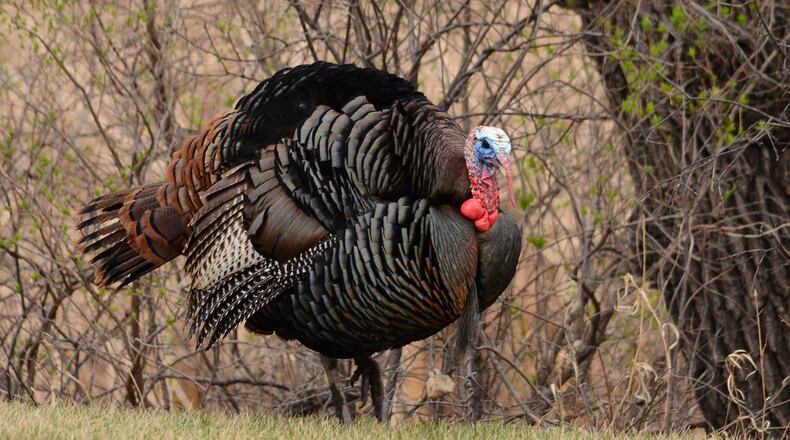With keen eyesight and a sensory system on high alert in an ever-greening and awakening springtime woods, a motionless mound on the forest floor is about the only thing that won’t draw a gobbler’s attention. To someone not familiar with wild turkeys, dressing as a pile of leaves to outwit a bird seems ridiculous. To a hunter trying to fill a spring tag with success rates hovering at slightly better than 1 in 4 in the best years, it seems like the minimum requirement.
Hunting — in the spring?
For nearly every other species, hunting seasons start in a month that ends with an “R.” Not the turkey. The traditional turkey hunting season happens during the breeding season. In Ohio, that means April and May. While it doesn’t coincide with Thanksgiving, it is the biggest game in town this time of year. Literally, they’re big birds standing up to four feet tall. The weather is warming and people are ready to get outside. The calling style of hunting amps up the excitement. Only male turkeys that have a visible “beard”— a strange group of feathers that grows in the middle of their chest throughout their life — are legal game in the spring
Seasonal transition
Through most of the year, wild turkeys stay in groups divided by sex and age. Hens stay with hens. Juvenile males, called jakes, associate with their peers. Adult males, toms or gobblers, hang with their kind. That changes in the spring. Tom turkeys separate and establish individual ranges. They gobble, strut, fan their extensive tail feathers, and fight other males in displays of dominance. Their goal is to attract and retain an exclusive harem of hens.
Adding ip the challenges
The result for hunters is a big set of challenges, reflected in the success rates. Like mentioned previously, springtime hunting is done by calling turkeys to the hunter, typically by mimicking the sounds of a hen. There’s the rub. The hens are supposed to go to the gobbler. The legal equipment for harvesting is limited to shotguns, longbows, or crossbows.
So, to recap, hunters have to not only convince a gobbler to leave his harem, something he’s not want to do, but to come into effective shotgun or archery range of around 35 yards. They have to remain virtually motionless to avoid detection by some of the most powerful eyes in nature while those same eyes are searching for the source of the sound to add to his harem. Other than calling, they must remain silent and undetected by other turkeys in the area, lest they sound the alarm. Lastly, they have to position themselves for a shot without being detected.
All in all, that’s a long list of things that have to go right and that could go wrong, and we haven’t begun to scratch the surface. Turkeys that won’t cross a creek. Fences. Other gobblers. Another hen. The list goes on. Those hurdles, combined with the unique Dr. Dolittle experience of one-to-one interaction between a human and gobbler hook folks like Mr. Bales and keep them coming back for more. But for a couple of timely decisions, it might have been something that few would have ever been able to experience.
Nearly lost
Change was the word at the turn of the last century. In 1903, as the Wright Brothers were taking to the skies, populations of some birds were decidedly not. The last wild passenger pigeon was shot in 1900 in Southern Ohio. Heath hen numbers hung by a thread in the low hundreds on the east coast. And in 1904, through lost habitat and over-harvest, wild turkeys were eliminated from Ohio.
Fortunately, turkey habitat came back, better regulations were established, and reintroduction by the Ohio Division of Wildlife began in the 1950s. By 1966, a limited season was allowed in nine counties. In 1999, wild turkeys were found in all 88 counties, and the spring season was open statewide in 2000. It has been open across the state since.
Get ready now
The 2025 Turkey season in southwest Ohio kicks off with a weekend youth season on April 12 and 13th, followed by the general season opening April 19th and running through May 18.
The limit is one bearded gobbler per year. Hunters that require a hunting license will also need to purchase a turkey tag, and all successful hunters must check in their harvest. Getting started can seem overwhelming — there are a lot of details and things to learn. Safety first needs to be a real thing in the spring woods. The Ohio Department of Resources has specific resources to get you started. Some are listed below.
If I was starting now, I’d learn the basics of turkey hen language and gobbler response. I’d scout a location, looking and listening for turkeys, and I’d get there early. Then I’d do my level best to appear to everything in the forest (except other hunters) like a pile of leaves.
Devin Meister is a local outdoors and wildlife enthusiast and has a blog called “Average Guy Outdoors.” He is an Ohio University graduate. Reach him at meister.devin@gmail.com.
About the Author


